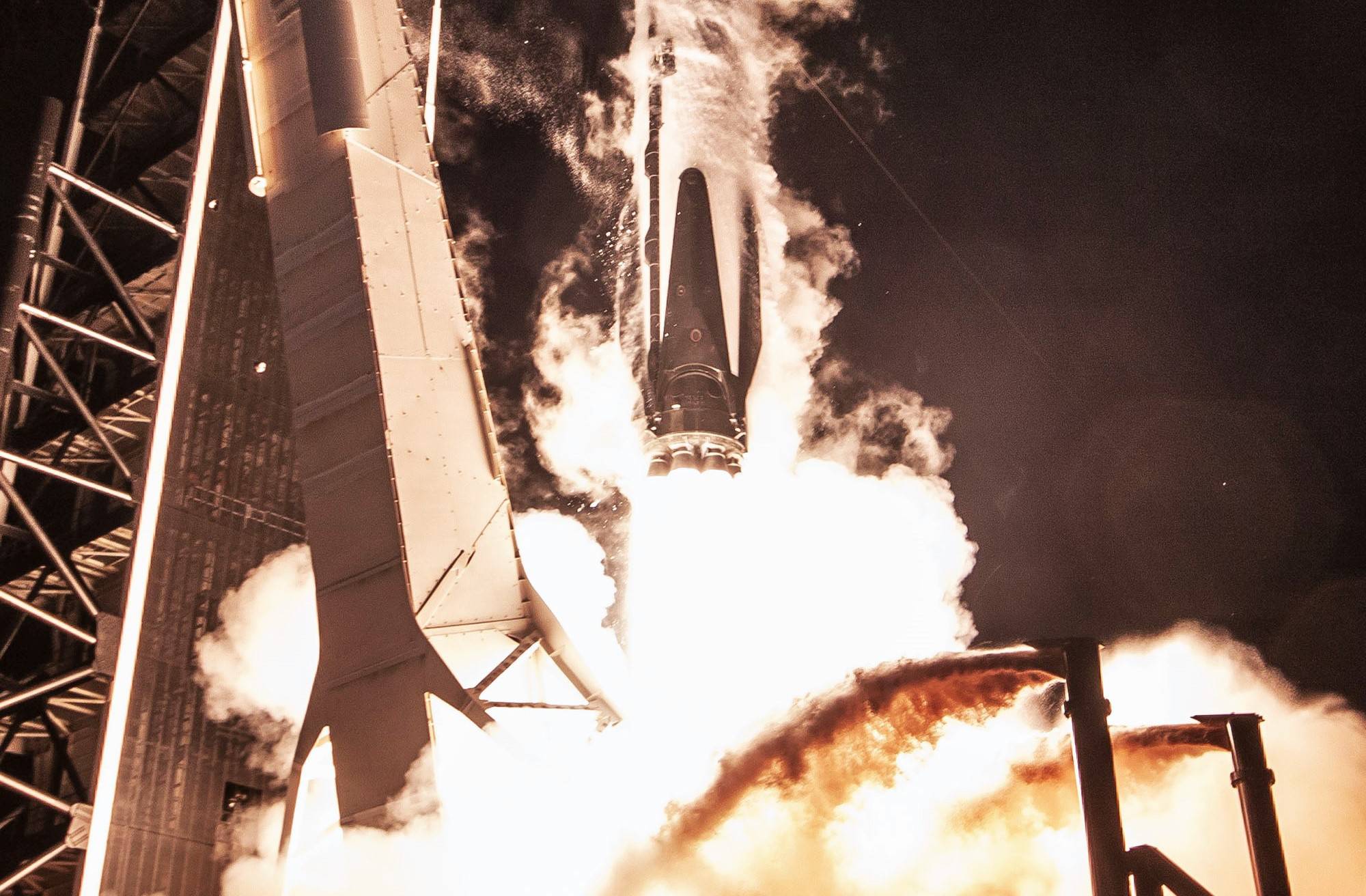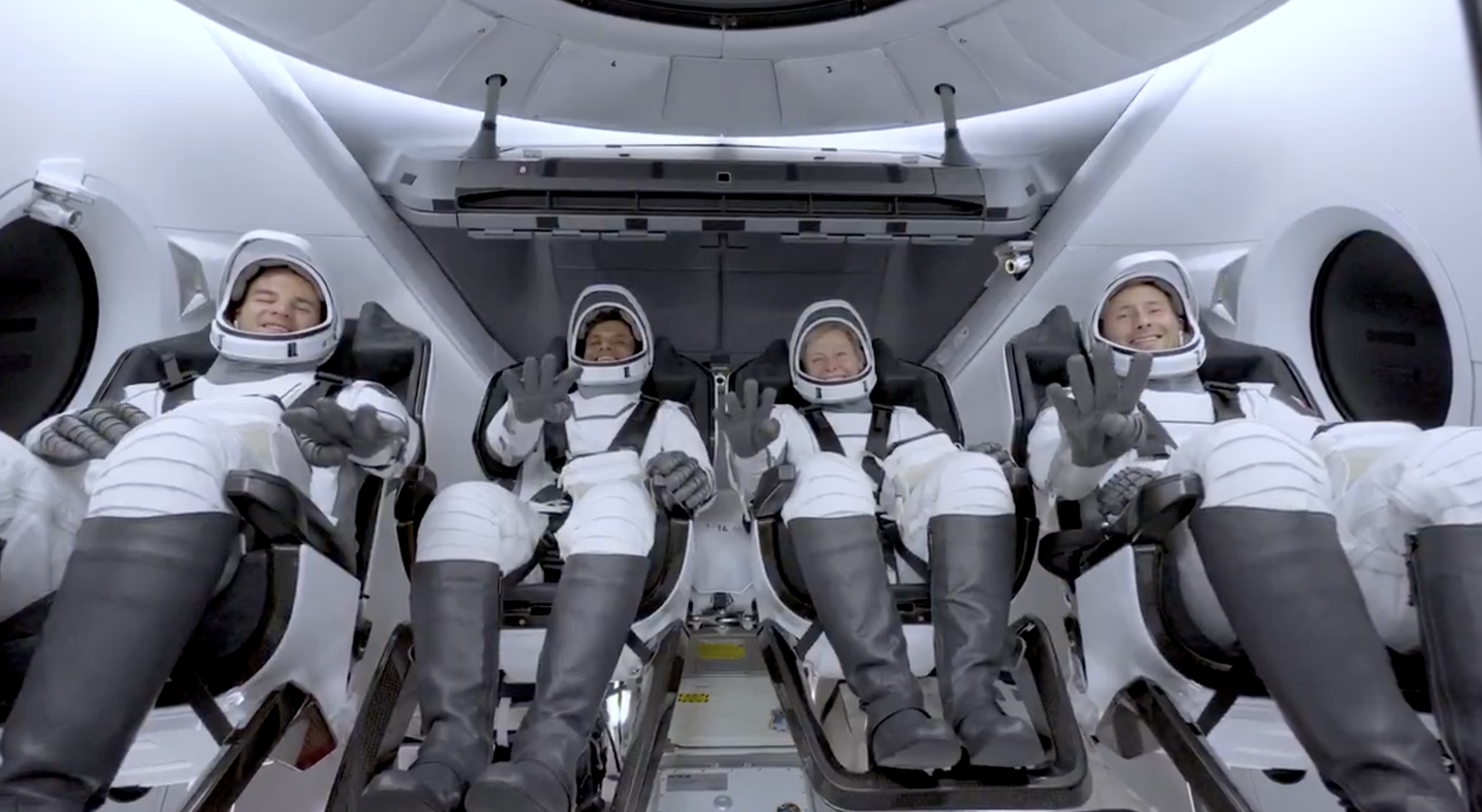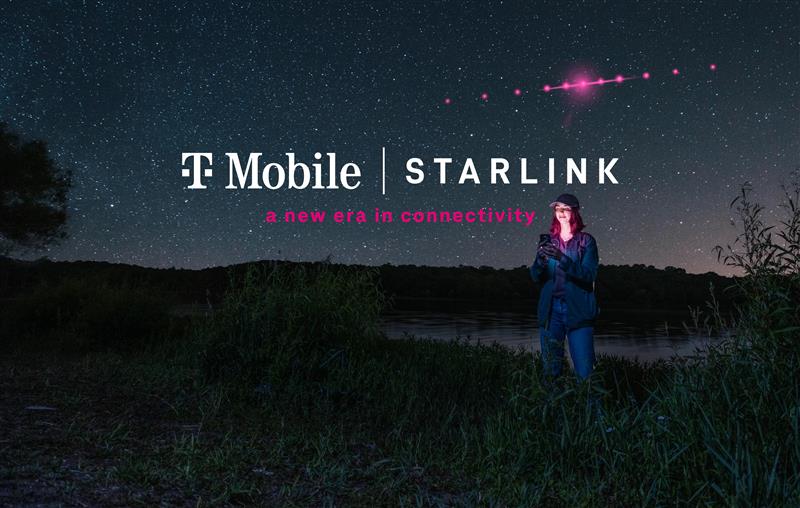

SpaceX
SpaceX’s Falcon 9 to launch new Starlink satellites from Florida this spring
NASASpaceflight.com reports that SpaceX is tentatively on target for the dedicated launch debut of its first (relatively) operational Starlink satellites as early as mid-May, indicating that the company might actually meet an extremely ambitious deadline set last year by CEO Elon Musk.
Although the CEO had briefly hinted that SpaceX would launch at least one additional round of prototype satellites – complementing the two launched in February 2018 – before moving to dedicated Starlink missions, all signs point to this mystery case being a dedicated Falcon 9 launch. Whether or not the aggressive mid-May schedule holds, the first launch of operational Starlink satellites would be a huge milestone for SpaceX’s low Earth orbit (LEO) internet constellation, meant to eventually provide high-quality, affordable broadband access to almost anyone on Earth.
Linking the stars in phases
In November 2018, SpaceX filed a modification to the license it been previously granted by the FCC (Federal Communications Commission) in March, requesting that it be allowed to dramatically change the first phase of its Starlink satellite constellation. In short, SpaceX wanted to find a faster and cheaper way to deploy its first Starlink satellites as quickly as possible.
“[SpaceX] will utilize key elements from its experimental satellites, such as its sophisticated phased-array antennas and its advanced Hall-effect thrusters, as the foundation of a more efficient and cost-effective architecture that can rapidly accelerate deployment for the overall constellation while optimizing space safety.” – Starlink FCC license modification request, SpaceX, 11/8/2018
This modification almost certainly arose as a direct result of CEO Elon Musk’s June 2018 ultimatum, in which he reportedly fired Starlink executives deemed uncooperative in order to rapidly speed up the constellation’s time-to-market. In fact, according to Reuters, Musk challenged the Starlink team to begin launching the constellation’s first operational satellites just one year later (June 2019), an extraordinary aspiration standing a handful of months after the group had launched its first two early satellite prototypes. According to a source
While both sides presumably have good reasons for their stubborn preferences, Musk may well be in the right at the end of the day, particularly given the sheer level of competition to complete LEO internet constellations and begin serving customers. An overly cautious approach could risk being so late to market that multiple competitors, ranging from relatively established entrants OneWeb and Telesat to more obscure companies like WorldVu and Space Norway. Barely a week ago, OneWeb completed the first successful launch of its constellation, placing six demonstration satellites in orbit to prove their technology and reduce risk prior to commencing operational launches with 30+ satellites apiece. Furthermore, both Tesla and SpaceX have more or less flourished while using the same approach, evidenced by a culture of continuous improvement where both electric cars and rocket engines are constantly upgraded and improved upon. Falcon 9 famously features a bevy of versions or “blocks”, culminating recently in Falcon 9 Block 5’s major reusability and reliability optimizations.

A little crazy, but it works
Whether or not Musk can be more than a little crazy, it’s nearly impossible to coherently deny the fact that his strategy of delivering a minimum viable product as quickly as possible and gradually improving it over time has a polished record of success. Once again, Falcon 9 is the best and most relevant example in the context of Starlink. SpaceX’s now-workhorse rocket began in a form (Falcon 9 V1.0) nearly unrecognizable compared to its most recent edition, featuring far less performance, no reusability, and an older and less capable version of Merlin. Falcon 9 V1.1 was a radical – almost clean-sheet –
In short, when Elon Musk and other SpaceX engineers originally conceived of Falcon 9 in the early 2000s, 2018’s Falcon 9 Block 5 was effectively the rocket they were imagining. Rather than spending countless hundreds of millions of dollars to privately design, test, and redesign multiple prototype iterations, Musk et al built a minimum viable product, began launching payloads for paying customers (both government and commercial), and used the company’s reputation, commercial success, and flight experience to shape Falcon 9 into the industry leader it is today.
Put simply, there is no reason to think that the same approach will not prove equally fruitful when applied to satellites instead of rockets. While SpaceX has yet to receive an FCC grant for its Starlink modification request, the company summarized its updated strategy in the November 2018 filing. The request effectively “relocates” the first phase of its 4,425 (now 4209) satellite LEO constellation, moving 1584 satellites from an 1100 km to 550 km orbit and simplifying the design of the first operational spacecraft by using just one spectrum segment (Ku-band) instead of two (Ku- and Ka-band). Hardware to exploit that additional spectrum will be developed and added to Starlink satellites and ground hardware down the road. As such, regardless of how unrefined SpaceX’s first operational Starlink satellites could be, the launch will be just as much of a milestone.

SpaceX will also be able to demonstrate a truly unique aspect of Starlink that helps bolsters its competitive advantage: vertically integrated production and launch of its satellites. Based on FCC permit requests filed last month, SpaceX plans to conduct the first dedicated launch from its Florida-based LC-40 pad, with the Falcon 9 booster landing more than 600 km (370 mi) offshore on drone ship
In other words, Starlink’s operational debut could very well be the heaviest payload SpaceX has yet to launch on a single mission. Weighing less than 500 kg apiece with a dispenser (per Iridium NEXT) around 10% of the total payload mass, SpaceX will likely launch anywhere from 20-40 Starlink satellites at once, depending on the final mass of these first spacecraft and their custom-built dispenser. While delays from the late-April to mid-May launch target are arguably quite likely, the fact that the first operational Starlink launch is tentatively scheduled even less than half a year away bodes very well for tangible constellation progress in 2019.
Check out Teslarati’s Marketplace! We offer Tesla accessories, including for the Tesla Cybertruck and Tesla Model 3.
News
SpaceX’s Crew-11 mission targets July 31 launch amid tight ISS schedule
The flight will lift off from Launch Complex 39A at Kennedy Space Center in Florida.

NASA and SpaceX are targeting July 31 for the launch of Crew-11, the next crewed mission to the International Space Station (ISS). The flight will lift off from Launch Complex 39A at Kennedy Space Center in Florida, using the Crew Dragon Endeavour and a Falcon 9 booster.
Crew Dragon Endeavour returns
Crew-11 will be the sixth flight for Endeavour, making it SpaceX’s most experienced crew vehicle to date. According to SpaceX’s director of Dragon mission management, Sarah Walker, Endeavour has already carried 18 astronauts representing eight countries since its first mission with NASA’s Bob Behnken and Doug Hurley in 2020, as noted in an MSN report.
“This Dragon spacecraft has successfully flown 18 crew members representing eight countries to space already, starting with (NASA astronauts) Bob (Behnken) and Doug (Hurley) in 2020, when it returned human spaceflight capabilities to the United States for the first time since the shuttle retired in July of 2011,” Walker said.
For this mission, Endeavour will debut SpaceX’s upgraded drogue 3.1 parachutes, designed to further enhance reentry safety. The parachutes are part of SpaceX’s ongoing improvements to its human-rated spacecraft, and Crew-11 will serve as their first operational test.
The Falcon 9 booster supporting this launch is core B1094, which has launched in two previous Starlink missions, as well as the private Ax-4 mission on June 25, as noted in a Space.com report.
The four-members of Crew-11 are NASA astronauts Zena Cardman and Mike Fincke, as well as Japan’s Kimiya Yui and Russia’s Oleg Platonov.
Tight launch timing
Crew-11 is slated to arrive at the ISS just as NASA coordinates a sequence of missions, including the departure of Crew-10 and the arrival of SpaceX’s CRS-33 mission. NASA’s Bill Spetch emphasized the need for careful planning amid limited launch resources, noting the importance of maintaining station altitude and resupply cadence.
“Providing multiple methods for us to maintain the station altitude is critically important as we continue to operate and get the most use out of our limited launch resources that we do have. We’re really looking forward to demonstrating that capability with (CRS-33) showing up after we get through the Crew-11 and Crew-10 handover,” Spetch stated.
News
SpaceX launches Ax-4 mission to the ISS with international crew
The SpaceX Falcon 9 launched Axiom’s Ax-4 mission to ISS. Ax-4 crew will conduct 60+ science experiments during a 14-day stay on the ISS.

SpaceX launched the Falcon 9 rocket kickstarting Axiom Space’s Ax-4 mission to the International Space Station (ISS). Axiom’s Ax-4 mission is led by a historic international crew and lifted off from Kennedy Space Center’s Launch Complex 39A at 2:31 a.m. ET on June 25, 2025.
The Ax-4 crew is set to dock with the ISS around 7 a.m. ET on Thursday, June 26, 2025. Axiom Space, a Houston-based commercial space company, coordinated the mission with SpaceX for transportation and NASA for ISS access, with support from the European Space Agency and the astronauts’ governments.
The Ax-4 mission marks a milestone in global space collaboration. The Ax-4 crew, commanded by U.S. astronaut Peggy Whitson, includes Shubhanshu Shukla from India as the pilot, alongside mission specialists Sławosz Uznański-Wiśniewski from Poland and Tibor Kapu from Hungary.
“The trip marks the return to human spaceflight for those countries — their first government-sponsored flights in more than 40 years,” Axiom noted.
Shukla’s participation aligns with India’s Gaganyaan program planned for 2027. He is the first Indian astronaut to visit the ISS since Rakesh Sharma in 1984.
Axiom’s Ax-4 mission marks SpaceX’s 18th human spaceflight. The mission employs a Crew Dragon capsule atop a Falcon 9 rocket, designed with a launch escape system and “two-fault tolerant” for enhanced safety. The Axiom mission faced a few delays due to weather, a Falcon 9 leak, and an ISS Zvezda module leak investigation by NASA and Roscosmos before the recent successful launch.
As the crew prepares to execute its scientific objectives, SpaceX’s Ax-4 mission paves the way for a new era of inclusive space research, inspiring future generations and solidifying collaborative ties in the cosmos. During the Ax-4 crew’s 14-day stay in the ISS, the astronauts will conduct nearly 60 experiments.
“We’ll be conducting research that spans biology, material, and physical sciences as well as technology demonstrations,” said Whitson. “We’ll also be engaging with students around the world, sharing our experience and inspiring the next generation of explorers.”
SpaceX’s Ax-4 mission highlights Axiom’s role in advancing commercial spaceflight and fostering international partnerships. The mission strengthens global space exploration efforts by enabling historic spaceflight returns for India, Poland, and Hungary.
News
Starlink Cellular’s T-Mobile service to grow with third-party app data
From Oct 2025, T-Satellite will enable third-party apps in dead zones! WhatsApp, X, AccuWeather + more coming soon.

Starlink Cellular’s T-Mobile service will expand with third-party app data support starting in October, enhancing connectivity in cellular dead zones.
T-Mobile’s T-Satellite, supported by Starlink, launches officially on July 23. Following its launch, T-Mobile’s Starlink Cellular service will enable data access for third-party apps like WhatsApp, X, Google, Apple, AccuWeather, and AllTrails on October 1, 2025.
T-Mobile’s Starlink Cellular is currently in free beta. T-Satellite will add MMS support for Android phones on July 23, with iPhone support to follow. MMS support allows users to send images and audio clips alongside texts. By October, T-Mobile will extend emergency texting to all mobile users with compatible phones, beyond just T-Mobile customers, building on its existing 911 texting capability. The carrier also provides developer tools to help app makers integrate their software with T-Satellite’s data service, with plans to grow the supported app list.
T-Mobile announced these updates during an event celebrating an Ookla award naming it the best U.S. phone network, a remarkable turnaround from its last-place ranking a decade ago.
“We not only dream about going from worst to best, we actually do it. We’re a good two years ahead of Verizon and AT&T, and I believe that lead is going to grow,” said T-Mobile’s Chief Operating Officer Srini Gopalan.
T-Mobile unveiled two promotions for its Starlink Cellular services to attract new subscribers. A free DoorDash DashPass membership, valued at $10/month, will be included with popular plans like Experience Beyond and Experience More, offering reduced delivery and service fees. Meanwhile, the Easy Upgrade promotion targets Verizon customers by paying off their phone balances and providing flagship devices like the iPhone 16, Galaxy S25, or Pixel 9.
T-Mobile’s collaboration with SpaceX’s Starlink Cellular leverages orbiting satellites to deliver connectivity where traditional networks fail, particularly in remote areas. Supporting third-party apps underscores T-Mobile’s commitment to enhancing user experiences through innovative partnerships. As T-Satellite’s capabilities grow, including broader app integration and emergency access, T-Mobile is poised to strengthen its lead in the U.S. wireless market.
By combining Starlink’s satellite technology with strategic promotions, T-Mobile is redefining mobile connectivity. The upcoming third-party app data support and official T-Satellite launch mark a significant step toward seamless communication, positioning T-Mobile as a trailblazer in next-generation wireless services.
-

 Elon Musk2 weeks ago
Elon Musk2 weeks agoTesla investors will be shocked by Jim Cramer’s latest assessment
-

 News2 days ago
News2 days agoTesla debuts hands-free Grok AI with update 2025.26: What you need to know
-

 Elon Musk4 days ago
Elon Musk4 days agoxAI launches Grok 4 with new $300/month SuperGrok Heavy subscription
-

 Elon Musk7 days ago
Elon Musk7 days agoElon Musk confirms Grok 4 launch on July 9 with livestream event
-

 News1 week ago
News1 week agoTesla Model 3 ranks as the safest new car in Europe for 2025, per Euro NCAP tests
-

 Elon Musk2 weeks ago
Elon Musk2 weeks agoxAI’s Memphis data center receives air permit despite community criticism
-

 News4 days ago
News4 days agoTesla begins Robotaxi certification push in Arizona: report
-

 News2 weeks ago
News2 weeks agoTesla sees explosive sales growth in UK, Spain, and Netherlands in June

















